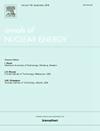Deployment of neural-network-based neutron microscopic cross sections in the Griffin reactor physics application
IF 1.9
3区 工程技术
Q1 NUCLEAR SCIENCE & TECHNOLOGY
引用次数: 0
Abstract
The use of reduced-order models for the efficient evaluation of microscopic cross sections has shown significant promise in Griffin reactor physics applications. Among various reduced-order techniques, neural network-based models stand out for their exceptional scalability, memory efficiency, prediction speed, and compatibility with the MOOSE (Multiphysics Object-Oriented Simulation Environment) framework. This work develops capabilities into the Griffin reactor physics application to utilize neural networks to predict microscopic cross-section parametric spaces for a variety of nuclides. The LibTorch interface enables Griffin’s MOOSE based materials to interact with LibTorch-trained models, allowing for the evaluation of complex microscopic cross-section spaces, which are then used to evaluate the neutronic properties of the Griffin finite-element model. This study benchmarks traditional ISOXML-formatted tabulation libraries against neural-network-based models for 279 nuclides on 20,160 grid points for zero- and two-dimensional reactor models. Benchmark metrics include the fundamental mode eigenvalue, fission and absorption rates, and various temperature coefficients of reactivity (isothermal, fuel, and moderator). From the perspective of storage space, the complete set of LibTorch models uses 11 MB, compared to the 10 GB for the ISOXML multigroup library that covers the same grid space. For the two-dimensional performance case considered in Griffin, the LibTorch model uses 97% less random access memory than the reference ISOXML dataset while runtime increases by a factor of 3 when using the LibTorch model compared to the ISOXML dataset with multilinear interpolation. The LibTorch model consistently yields errors within 0.01% for most analyzed quantities except for the temperature coefficients of reactivity where the maximum discrepancies are up to 0.3 . Due to the neural network attempting to best predict quantities with no regard for a positive or negative bias for any given quantity, predictions may experience random fluctuations, resulting in both positive and negative errors. Future work will entail both a depletion and coupled transient analysis to determine the predictive capabilities of Griffin with neural-network-based cross sections.
基于神经网络的中子微观截面在Griffin反应堆物理应用中的部署
使用降阶模型对微观截面进行有效评估,在格里芬反应堆物理应用中显示出巨大的前景。在各种降阶技术中,基于神经网络的模型以其卓越的可扩展性、内存效率、预测速度以及与MOOSE(多物理场面向对象仿真环境)框架的兼容性而脱颖而出。这项工作开发了Griffin反应堆物理应用程序的能力,利用神经网络预测各种核素的微观截面参数空间。LibTorch接口使Griffin的基于MOOSE的材料能够与LibTorch训练的模型相互作用,允许评估复杂的微观横截面空间,然后用于评估Griffin有限元模型的中子特性。这项研究将传统的isxml格式的制表库与基于神经网络的模型进行了对比,其中279种核素分布在20,160个网格点上,用于零和二维反应堆模型。基准指标包括基本模式特征值,裂变和吸收率,以及各种反应性温度系数(等温,燃料和慢化剂)。从存储空间的角度来看,LibTorch模型的完整集合使用11mb,而覆盖相同网格空间的isoml多组库使用10gb。对于Griffin所考虑的二维性能情况,LibTorch模型使用的随机访问内存比参考isxml数据集少97%,而与使用多线性插值的isxml数据集相比,LibTorch模型的运行时间增加了3倍。对于大多数分析量,LibTorch模型的误差始终在0.01%以内,除了反应性温度系数的最大误差可达0.3 pcmK。由于神经网络试图最好地预测数量,而不考虑任何给定数量的正或负偏差,预测可能会经历随机波动,导致正和负误差。未来的工作将包括耗尽和耦合瞬态分析,以确定Griffin基于神经网络的横截面的预测能力。
本文章由计算机程序翻译,如有差异,请以英文原文为准。
求助全文
约1分钟内获得全文
求助全文
来源期刊

Annals of Nuclear Energy
工程技术-核科学技术
CiteScore
4.30
自引率
21.10%
发文量
632
审稿时长
7.3 months
期刊介绍:
Annals of Nuclear Energy provides an international medium for the communication of original research, ideas and developments in all areas of the field of nuclear energy science and technology. Its scope embraces nuclear fuel reserves, fuel cycles and cost, materials, processing, system and component technology (fission only), design and optimization, direct conversion of nuclear energy sources, environmental control, reactor physics, heat transfer and fluid dynamics, structural analysis, fuel management, future developments, nuclear fuel and safety, nuclear aerosol, neutron physics, computer technology (both software and hardware), risk assessment, radioactive waste disposal and reactor thermal hydraulics. Papers submitted to Annals need to demonstrate a clear link to nuclear power generation/nuclear engineering. Papers which deal with pure nuclear physics, pure health physics, imaging, or attenuation and shielding properties of concretes and various geological materials are not within the scope of the journal. Also, papers that deal with policy or economics are not within the scope of the journal.
 求助内容:
求助内容: 应助结果提醒方式:
应助结果提醒方式:


